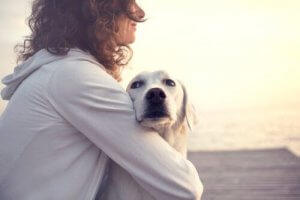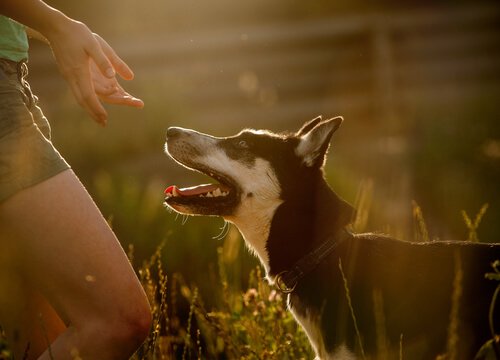Did You Know that Dogs Can Detect Diabetes?

When we hear about service dogs we tend to think about guide dogs for the blind. However, we’ve been learning more and more about all the things our furry friends can do for us. These are mainly due to their extraordinary sense of smell. As the list of tasks for service dogs grows, the more potential we see in them. For example, we recently learned that dogs can also detect diabetes.
Diabetes is a metabolic disorder consequence of an excess of blood sugar. This disorder can eventually affect other organs of the body such as the kidneys, eyes and blood vessels; it can even lead to cardiovascular disease.
The main symptoms of diabetes are frequent urination, fatigue, slow healing wounds, excessive thirst and hunger, weight loss or gain, irritability, blurred vision, and nausea, among others. And, an increase in blood sugar can lead to death. This is why detecting this condition in time could save your life.
This is where your dog can play another important role in your life. The fact that they can also detect diabetes is highly beneficial to all humans.
How can dogs detect diabetes?

As with canine cancer detection, many believe that dogs can also detect diabetes thanks to their acute olfactory abilities. However, nobody really knows for sure if it’s the smell that helps a dog know that a person’s blood sugar is about to increase.
What’s certain is the degree of success with which they can predict it: around 98%. A rather high percentage and a good indicator that this kind of service dog can greatly help humans.
Training of service dogs
There are several organizations for this purpose around the world. In the USA, there’s at least one that offers training services as well as already-trained animals.
The training of a new animal takes approximately a year. Service dogs are not only trained to detect high blood sugar levels but also to lower them. In fact, dogs know how to react in several ways to a person who’s having a high or low blood sugar episode.
However, training a dog to recognize the symptoms of an increase in blood sugar often takes precedence as these are more difficult to detect and are far more dangerous for the owner.
Genetic testing was applied to several dog breeds in order to find out if they have what it takes for a service job. The results: Jack Russell Terriers are the most suited for it.
However, any breed can do the job if trained for it. The person afflicted with diabetes can discuss it with the organizations and receive advice from them.
The training of service dogs involves teaching them not to bark for any reason other than what relates to their owner’s illness. That is, a dog trained to detect diabetes will only bark when it feels their owner’s blood sugar levels are about to increase or decrease.
Amazingly, dogs can detect these changes in advance and with enough time for the diabetic person to measure their blood sugar levels. This way they’ll be able to determine if their blood sugar levels are increasing or decreasing and act accordingly.
Cini, a trained service dog

Cini is the dog of a 19-year-old girl named Lidia, diagnosed with diabetes when she was 5 years old. Having to adapt to that kind of lifestyle was very hard. What an unpleasant condition diabetes is for a child, who has to monitor blood sugar levels frequently, instead of exploring and playing.
At first, Lidia couldn’t understand what she should do or how to do it and her life seemed like a nightmare. But little by little she learned to live with it. This is when Cini, her lifesaver who also became a most faithful friend, arrived.
Cini is one of the first dogs to be trained for this purpose in the world. She only barks when she senses that Lidia’s blood sugar levels are about to increase or decrease. According to Lidia, Cini’s never wrong. She only barks whenever a significant change in her body is about to take place.
According to Lidia, Cini is her life insurance and gives her peace of mind. Before, she was afraid of staying home alone and even had trouble allowing herself to fall asleep for fear that if something happened she may not be able to take immediate action. Those fears disappeared from the moment Cini came into her life.
How thankful we should be for animals willing to protect us in so many important ways!
When we hear about service dogs we tend to think about guide dogs for the blind. However, we’ve been learning more and more about all the things our furry friends can do for us. These are mainly due to their extraordinary sense of smell. As the list of tasks for service dogs grows, the more potential we see in them. For example, we recently learned that dogs can also detect diabetes.
Diabetes is a metabolic disorder consequence of an excess of blood sugar. This disorder can eventually affect other organs of the body such as the kidneys, eyes and blood vessels; it can even lead to cardiovascular disease.
The main symptoms of diabetes are frequent urination, fatigue, slow healing wounds, excessive thirst and hunger, weight loss or gain, irritability, blurred vision, and nausea, among others. And, an increase in blood sugar can lead to death. This is why detecting this condition in time could save your life.
This is where your dog can play another important role in your life. The fact that they can also detect diabetes is highly beneficial to all humans.
How can dogs detect diabetes?

As with canine cancer detection, many believe that dogs can also detect diabetes thanks to their acute olfactory abilities. However, nobody really knows for sure if it’s the smell that helps a dog know that a person’s blood sugar is about to increase.
What’s certain is the degree of success with which they can predict it: around 98%. A rather high percentage and a good indicator that this kind of service dog can greatly help humans.
Training of service dogs
There are several organizations for this purpose around the world. In the USA, there’s at least one that offers training services as well as already-trained animals.
The training of a new animal takes approximately a year. Service dogs are not only trained to detect high blood sugar levels but also to lower them. In fact, dogs know how to react in several ways to a person who’s having a high or low blood sugar episode.
However, training a dog to recognize the symptoms of an increase in blood sugar often takes precedence as these are more difficult to detect and are far more dangerous for the owner.
Genetic testing was applied to several dog breeds in order to find out if they have what it takes for a service job. The results: Jack Russell Terriers are the most suited for it.
However, any breed can do the job if trained for it. The person afflicted with diabetes can discuss it with the organizations and receive advice from them.
The training of service dogs involves teaching them not to bark for any reason other than what relates to their owner’s illness. That is, a dog trained to detect diabetes will only bark when it feels their owner’s blood sugar levels are about to increase or decrease.
Amazingly, dogs can detect these changes in advance and with enough time for the diabetic person to measure their blood sugar levels. This way they’ll be able to determine if their blood sugar levels are increasing or decreasing and act accordingly.
Cini, a trained service dog

Cini is the dog of a 19-year-old girl named Lidia, diagnosed with diabetes when she was 5 years old. Having to adapt to that kind of lifestyle was very hard. What an unpleasant condition diabetes is for a child, who has to monitor blood sugar levels frequently, instead of exploring and playing.
At first, Lidia couldn’t understand what she should do or how to do it and her life seemed like a nightmare. But little by little she learned to live with it. This is when Cini, her lifesaver who also became a most faithful friend, arrived.
Cini is one of the first dogs to be trained for this purpose in the world. She only barks when she senses that Lidia’s blood sugar levels are about to increase or decrease. According to Lidia, Cini’s never wrong. She only barks whenever a significant change in her body is about to take place.
According to Lidia, Cini is her life insurance and gives her peace of mind. Before, she was afraid of staying home alone and even had trouble allowing herself to fall asleep for fear that if something happened she may not be able to take immediate action. Those fears disappeared from the moment Cini came into her life.
How thankful we should be for animals willing to protect us in so many important ways!
This text is provided for informational purposes only and does not replace consultation with a professional. If in doubt, consult your specialist.








